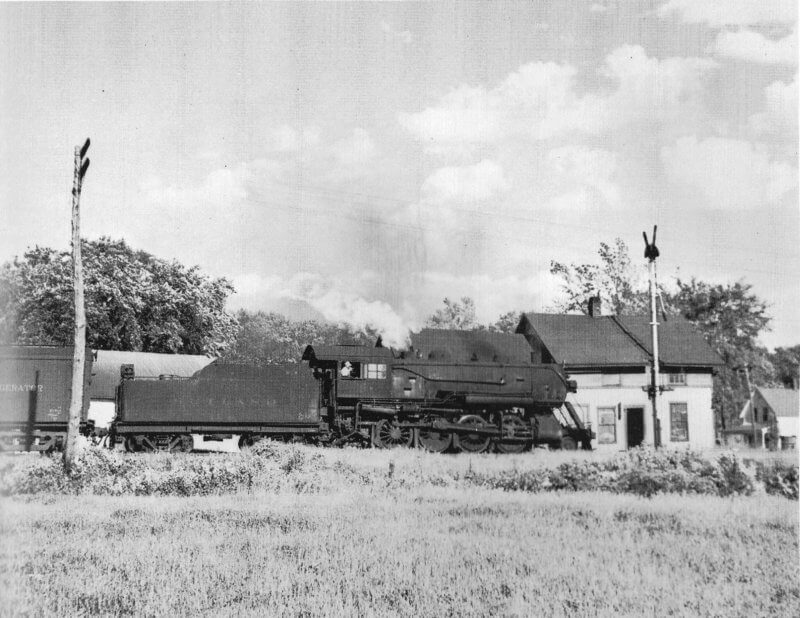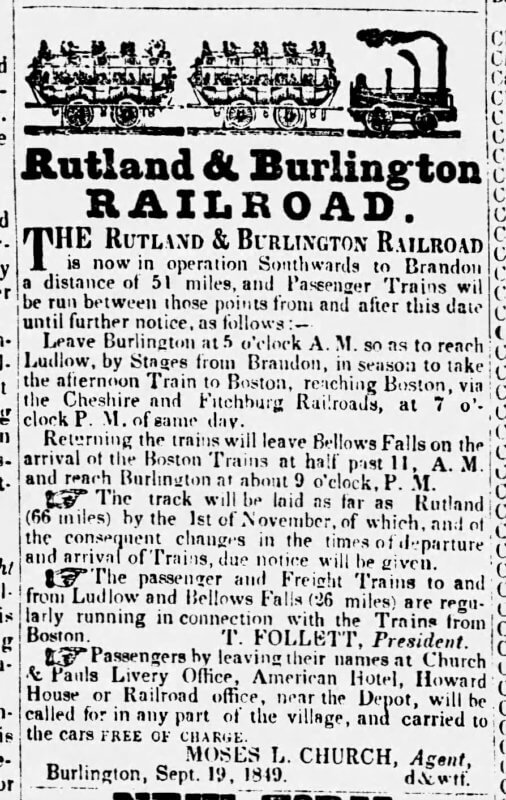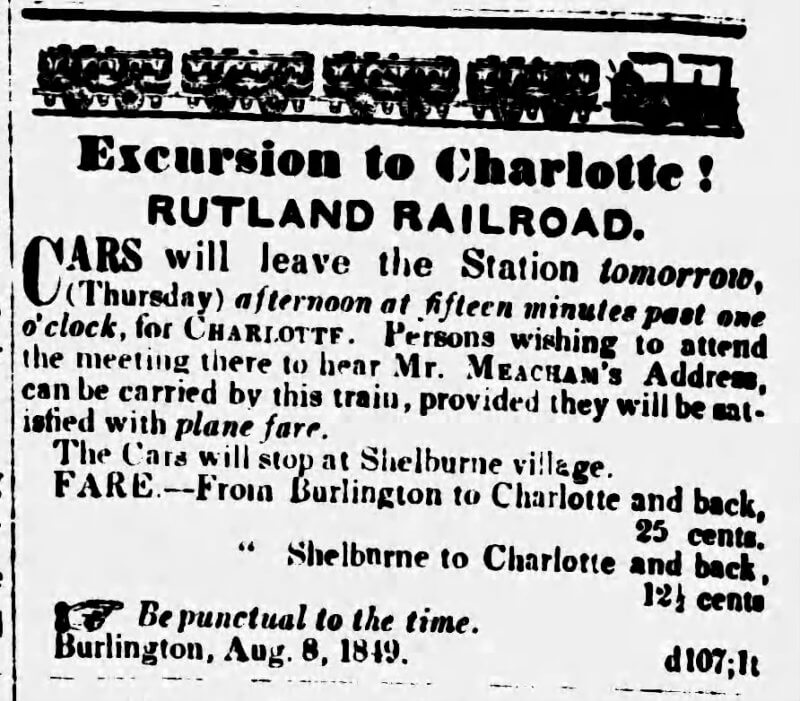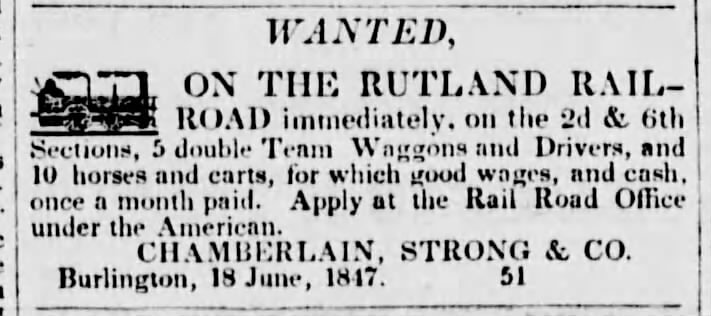Origins of the railroad through Charlotte
Two journalists from The Burlington Weekly Free Press traveled to Rutland in January 1847 to report on the new railroad’s stockholders meeting and spent two days bumping and lurching in sleigh and wagon to get there. They wrote that what took them two days of “unpleasantness” could be accomplished in two hours on the train. Cities and towns vied for railroads, expecting economic and social advantages over those communities bypassed by rail. In Charlotte, the West Village became the focus of the town, with nearby passenger and freight service, telegraph service, a milk transfer station, a mercantile building containing a general store, a grist mill, a feed store, a hay press, livery stables and storage sheds rented out.

Rail was promoted for rapid movement of people and produce, yet the Rutland would become plagued by a history of low profits, natural disasters and persistent labor problems.
In 1843, Burlington developer Timothy Follett was appointed president of a new railroad corporation and began to seek backers for a railroad with its terminus at the Burlington docks. The project would be known as the Lake Champlain-Connecticut River Railroad, connecting Burlington with Bellows Falls, via Rutland. Civil engineer William B. Gilbert surveyed the most efficient route, reporting on August 4, 1845 that grading would be contracted out while the corporation would absorb the cost of rails, ties and spikes, with the estimated cost for completion at $22,529.75 per mile—a total of $2.7 million.
Approximately half of the issued stock, 5392 shares, was purchased by 1304 farmers seeking more markets for their produce. In August 1845, according to The Boston Advertiser, Follett and the directors made a pitch in Boston for investment capital. Nervous investors worried other competing railroads like the Central Vermont would diminish potential income. Much of the legislative agenda was taken up by railroads being presented for incorporation.

Strident arguments filled the newspapers as wealthy challengers schemed to scuttle each other’s proposals. At the stockholders meeting on January 14, 1847, a committee decried the “back room” deals of competitors threatening to derail the entire project (after they had $1,000,000 subscribed) by discouraging prospective investors.
After several committee reports, the directors immediately awarded contracts in seven separate sections for the grading of the rail bed. On January 22, 1847, The Burlington Weekly Free Press promoted building the Rutland line, “because it will open at least 65 to 70 miles of a direct railway communication with New York [and the Boston and Atlantic markets], because of its cheapness as well as the very large amount of way-business alone which it must necessarily command, it cannot fail to be a profitable investment …”
On October 26, 1847, the Vermont Legislature officially renamed the Champlain-Connecticut River Railroad as the Rutland-Burlington Railroad Corporation—later shortened to just the Rutland Railroad.
A great discovery slowed work near Mt. Holly where, in early October 1848, workers uncovered an eight-by-four-inch fossil tooth in a peat bog. Nearby were two tusks and some bones that would later be identified as a wooly mammoth, which eventually became Vermont’s official terrestrial fossil.
The section passing through Charlotte, covering 50 miles from Burlington to Brandon, was awarded by the directors to Pratt & Company of Burlington, whose chairman, John Bradley, was Follett’s business partner. The bid was $7300 per mile for grading, masonry, bridging, land damages, etc. Despite aggressive efforts, by June 5, 1849, only five miles of this segment had been laid south from Burlington, and track was just beginning to be laid from Vergennes.

In early September 1849, workers uncovered strange bones in heavy blue clay in Charlotte. They were retrieved by naturalist, professor and clergyman Zadock Thompson, and discovered to be the bones of a saltwater beluga whale—now Vermont’s official marine fossil. At the time, geologists were confused, unaware that the weight of the glacier had depressed the Champlain Valley several hundred feet, allowing the Atlantic Ocean to rush in. It would be almost three millennia before the land rebounded enough to return Lake Champlain to fresh water.
In January 1850, the railroad was completed. When anticipated revenues fell short of projections, the railroad went bankrupt in 1853. Most of the large investors, like Timothy Follett, were financially ruined. By 1871, the line was leased to the rival Central Vermont, which in its turn was bankrupted by the machinations of the St. Albans-based Vermont-Canada Railroad, helped by a new group of investors on the board of the Rutland RR.

Since its inception, the Rutland RR endured monetary peaks and valleys, and managed to survive the Great Depression with the cooperation of its unions, whose members accepted lower pay and benefits to keep their jobs. Post World War II competition from developing airlines, along with improving highways, eroded rail profits. When Rutland businessman William Ginsburg became president in 1957, the railroad was facing financial straits due to ever-decreasing freight traffic and looming deficits, coinciding with the advent of the interstate highway system that favored trucking, and by increasing demands from labor unions. Ginsburg implemented improvements, attempting to modernize and meet federal standards by the only avenue left open to him: reductions in employees and service.
The employees should have anticipated the precarious position the railroad was in but walked off the job in September 1960. A federal court issued an injunction, and strikers were forced back to work, with a one-year moratorium on further strikes. But contentious discussions deadlocked. Believing he had no alternative to staving off ultimate bankruptcy, on Dec. 4, 1961, Ginsburg stunned everyone by petitioning the ICC for abandonment of the entire line. On Jan. 29, 1963, the Rutland Railroad was granted its petition for abandonment. Legal entanglements delayed the inevitable until Nov. 4, when the State of Vermont began purchasing sections that are now leased and managed by Vermont Railway.

